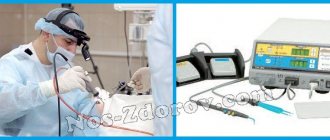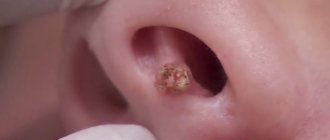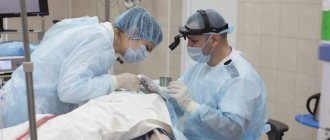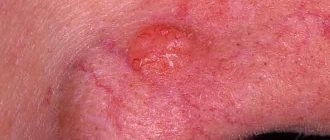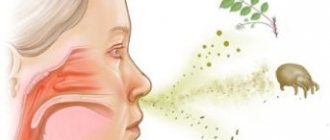The need to carry out therapeutic and diagnostic procedures by immersing instruments inside a particular organ is due to the accuracy of the method and the expansion of the clinical picture of the disease. During endoscopic manipulations, it is possible to conduct not only research, but also biopsy, removal of small neoplasms and tumors. Removal of polyps using a minimally invasive method using immersion instruments is called endoscopic polypectomy. Read more about the intervention technique, general dietary recommendations and features of patient management after surgery in this article.
Polypectomy – what is it?
Polypectomy is a surgical operation to remove polyps using special forceps or a metal loop. The operation can be performed for polypous lesions of almost any organs and tissues. Favorite locations for polyps are the uterus and intestines.
Therefore, common types of procedures are:
- uterine polypectomy (hysteroscopy with polypectomy);
- colon polypectomy, as well as endoscopic rectal polypectomy (colonoscopy, rectoscopy).
The manipulation requires mandatory preparation and the use of local or general anesthesia.
There are several ways to carry out intervention:
- Removal with cold forceps . Used for small polyps. Cold tongs are used as the main tool, but if necessary, the method is combined with other tools.
- Using hot tongs . Another name for surgery is electrocoagulation. The necessary instruments are applied to the polyposis lesion - forceps, which conduct current thanks to the attached electrodes. After removal of the polyp, an electrical impulse coagulates the vessels, preventing the development of complications.
- Loop polypectomy or "trap" . A special loop is advanced to the site of the growth, which tightens and cuts off the growth. The polypectomy snare is made of metal that conducts electricity. It is used for polyps with a diameter of more than 1-1.5 cm. After excision, coagulation of vessels of any direction can be used.
Any chosen method does not in any way affect the patient’s condition after and during surgery. The choice is determined by the size of the polyp and the degree of damage to the mucous membranes of the organs.
Laser technology for nasal polyp removal
The effect of laser on mucous tissue occurs in the form of a minimally invasive endoscopic procedure, which is characterized by low trauma to healthy tissues located close to the affected ones. By introducing an endoscope with a camera and special optics or camera, a nozzle that produces a laser beam penetrates the nasal cavities.
A study of the statistics of the results of the procedure suggests that, compared with traditional surgery, laser intervention:
- does not require general anesthesia;
- can be carried out not only in a hospital setting, but also in an outpatient clinic;
- has a low degree of trauma;
- carried out quickly;
- occurs with a minimal likelihood of bleeding, due to the simultaneous coagulation of damaged tissues.
The main disadvantages of the operation are that effective laser removal is only possible if the tumors are small in size and single in nature. It should also be noted that the procedure does not affect the causes of the disease, but only helps to cope with their consequences, so the probability of relapse is about 50%.
Endoscopic polypectomy - what is it?
Endoscopic polypectomy is an operation that is prescribed when the volume of the polyp is no more than 3 cm. Endoscopic intervention allows removal with particular precision, thanks to optical equipment, displaying the resulting image on a computer monitor and backlighting.
An endoscope is a device with probes and tips with optics and lighting. The endoscope has special passages for inserting surgical instruments.
Endoscopy can be combined with the classic forceps or loop removal method.
Endoscopic intervention is the preferred method of removal, as it allows several functions to be performed simultaneously:
- diagnostics and examination,
- treatment and removal,
- taking a biopsy sample for histology.
Laser polypectomy
Laser polypectomy of internal organ cavities is a surgical procedure using a laser beam. The direct influence of the laser evaporates moisture from the neoplasm and leads to tissue atrophy. After exposure, the growth is removed using forceps.
Despite the bloodlessness and speed of removal, lasers are rarely used in the cavities of internal organs.:
- Firstly, due to the difficulty of delivery through surgical routes.
- Secondly, high smoke during vaporization interferes with normal visualization and contributes to burns of healthy mucous membranes.
The use of a laser is not justified when excision of polyps removed more than 10 cm from the insertion site of endoscopic equipment, with thinned mucosa, as well as with a growth diameter of more than 3 cm. In addition, it is impossible to conduct histological and cytological studies for atypical cancer cells due to severe damage to the biopsy material.
Nasal polyps give you a headache. Signs of the disease
Nasal polyps begin to disturb the patient from the very beginning of the development of the disorder, but we don’t even think about how to determine their presence. The reason for this phenomenon is a good camouflage of the disease; it can be similar to a common cold.
Constant nasal congestion does not particularly bother the patient; he uses vasoconstrictor drops and even at first feels some relief. A slight but constant runny nose is the first symptom of the disease.
There are also other signs of nasal polyps, which we will look at in more detail.
- Anosmia is loss of sense of smell. It can be complete or partial when nasal polyps develop. This is due to the fact that in the tumor the functioning of the receptors that perceive odors is disrupted. It is sometimes difficult to restore the previous sensitivity even after a special operation.
- Sneezing. This is the body's natural defense, which turns on when foreign bodies enter the upper respiratory tract. A large polyp can irritate the cilia of the mucous membrane; it perceives it as a foreign body and tries to remove it from the body by sneezing.
- Nasal discharge. A runny nose in the first stage of polyposis is no different from a cold, except that it worries the patient all the time. Later, an admixture of pus and even blood appears in the mucus, which indicates the addition of secondary infections, which will be difficult to treat.
- Headache. A large tumor can put pressure on nerve endings, leading to constant headaches. This symptom can also cause oxygen starvation, since the body cells cannot normally receive air through the nose.
- Pain around the eyes. This symptom manifests itself especially often with antrochoanal polyps. Since the tumors are located in the paranasal sinuses, they can put pressure on the eyes, and the unpleasant sensations are especially pronounced when pressing on the skin. With advanced disease, it may even be difficult to move the eyelids.
- Foreign body sensation. The patient may feel a large polyp if it comes into contact with healthy areas of the mucosa. This is somewhat reminiscent of having dried mucus in the nose, but mechanical cleaning does not provide any relief.
- Loss of taste. An overgrown tumor can affect not only the sense of smell, but also the taste buds. This is due to dysfunction of receptors in hypertrophied mucous tissue.
- Hearing problems. A large polyp may partially or completely cover the entrance that leads from the nasopharynx to the auditory tube. This leads to hearing loss or complete hearing loss.
- Speech problems. In young children, polyps can cause speech impairment. If the disease is detected in an adult, then a nasal tone appears in the voice, the patient constantly speaks “into his nose.”
- Constantly slightly open lower jaw. As the polyp grows larger, it not only makes it difficult, but makes nasal breathing impossible. This leads to the fact that a person is forced to breathe through his mouth, because his lower jaw constantly sag.
- Changes in the facial skull and dental system. Most often, such serious symptoms occur in children, as their bones are still developing. A constantly open mouth leads to the fact that the nasolabial fold is smoothed out, the bite is disrupted, and sometimes even abnormal development of the chest is observed.
- Fast fatiguability. In the presence of a polyp, breathing is disrupted and, as a result, the supply of oxygen to all cells. This leads to insufficient working capacity of the brain and muscles; a person cannot engage in normal mental or physical activities.
- Disorders of appetite and digestion. Appetite disappears due to lack of taste and smell, as well as from chronic fatigue. Digestive disorders are most often observed when secondary infections are associated, because pathogenic microbes can penetrate the gastrointestinal tract.
Breathing problems. The polyp causes a constant runny nose; due to nasal congestion, a person is forced to breathe through the mouth. This is very dangerous, as dry and unpurified air enters the lungs. The allergens present in it can aggravate the patient's condition; insufficient moisture leads to drying out of the bronchial mucosa, which causes a painful dry cough.
Snore. During sleep, the polyp may partially or completely block the nasal passage, which causes the appearance of characteristic sounds when inhaling and exhaling. In some cases, even a short-term cessation of the patient's breathing during sleep (sleep apnea) is possible.
Polypectomy technique
There are two surgical approaches when performing the method: laparoscopic and endoscopic:
- In the first case, several small punctures are made through which the equipment is inserted.
- In the second, endoscopic equipment is introduced through natural routes.
The operation is performed according to the following algorithm:
- Preparing the patient (differential diagnosis, diet several days before the procedure, taking medications);
- Administration of anesthesia (local, general);
- Insertion of an endoscope using any surgical approach;
- Capturing the polyp with a loop and removing it, followed by coagulation of the vessels.
If there is no stem, an artificial stem is created before removal.
Endoscopy is not performed if the patient’s somatic status is aggravated, as well as with multiple polyps that cannot be counted, as well as with total damage to the mucous membranes of the organ. In this case, radical methods of removing tumors with resection of a part or an entire organ are indicated.
Hospitalization is usually not required after the intervention. Complications are rare. The main feature of the manipulation is the combination of several methods of removing polyps at once. Thus, polypectomy is often combined with scalpel removal or laser excision.
Gallbladder
Surgical intervention involves the removal of tumors inside the organ cavity. The surgical approach is laparoscopic. The instruments are inserted through small punctures in the peritoneum in the projection of the gallbladder.
During the operation, polyps are excised with a loop or forceps, and the wound surface is coagulated using electric current. For tumors larger than 1.5 cm, several operations may be required.
The operation is performed under general anesthesia. Removal is indicated for any tumors detected on ultrasound due to the risk of their malignancy. What are gallbladder polyps and how to treat them in more detail here.
Complications are kept to a minimum, but the risks of bleeding, secondary inflammation, and damage to healthy membranes always remain.
Emergency operations are performed in case of torsion of the polyp stalk, strangulation, or severe bleeding.
Kidneys
A progressive method for removing tumors on the surface of the kidneys is endoscopy with laparoscopic surgical access.
An important aspect of successful polyp removal is high-quality diagnosis and determination of the exact location of the growths. The kidneys can be accessed through incisions on the back and epigastric side. The operation is performed under general anesthesia.
After gaining access to the polypous lesion, it is removed, and the wound bed is sutured or coagulated. The early rehabilitation period takes place within the walls of a hospital.
Be sure to monitor blood counts:
- creatinine,
- urea,
- creatinine clearance,
- electrolytes.
In case of severe damage to the kidneys by polypous structures, as well as in case of malignancy of cells with an increase in chronic renal failure, nephrectomy is performed. After removal of one or both kidneys, patients are indicated for an organ transplant with regular dialysis therapy. Read about the symptoms of a kidney polyp in this article.
Nose
Before surgical removal, differential diagnostics are carried out to determine the exact localization of neoplasms: sinuses, sinuses, ethmoid epithelium, septum.
A radical treatment method is indicated for significant deterioration in nasal breathing, the development of hypoxia, and chronic sinusitis. Find out how polyps in the maxillary sinuses are removed here.
Endoscopic polypectomy is performed under general anesthesia. After the introduction of endoscopic equipment through the nasal passages, the growths are excised, followed by coagulation of the vessels using a laser and electric current.
All necessary incisions are made from the inside of the nose, so there are no external defects after healing. On the first day after removal, the nasal passages are packed. Scar tissue on the mucous membranes forms within 5-10 days.
Before, during and after the manipulation, the nose is rinsed abundantly to remove the mucous component. Frequent complications after nasal polypectomy are adhesions, bleeding, and infections.
Unfortunately, regardless of the treatment method, there is always a risk of relapse. Neoplasms appear next to the wound within a few years.
To prevent relapses, examinations by specialized specialists are recommended at least 2 times a year and control blood and urine tests.
Indications and contraindications for the procedure
Polypotomy is prescribed for: difficult nasal breathing; neurological disorders (insomnia, absent-mindedness and headaches); frequent attacks of bronchial asthma; regular obstructive bronchitis.
Content:
- Indications and contraindications for the procedure
- Features and methods of therapy
- Recovery after nasal polypotomy and complications
The procedure is contraindicated in the presence of: signs of incipient flu or acute respiratory viral infections; high blood pressure; acute infectious diseases; pulmonary and cardiovascular diseases; exacerbations of bronchial asthma and other allergic diseases.
To diagnose polyposis, you must consult an ENT doctor. The patient's complaints are taken into account, the nasal cavity is examined using an endoscope. Polyps located near the nostrils can be easily noticed and diagnosed. However, if the formation is located deep in the nasal passage, then additional measures will be required to clarify the diagnosis. In this case, CT or MRI is prescribed. These studies can determine the location of polyps, the level of inflammation and their size.
Management of patients after polypectomy
Recovery of the body after intervention completely depends on the localization of the removed tumors. If the polyps are small, single, and located along the path of the endoscope through natural pathways, then recovery occurs quickly.
Such patients are recommended to remain on protective regimen for up to 5 days, avoid physical activity, and take prescribed medications. The total duration of rehabilitation barely exceeds 10 days.
If the volume of the operation performed is significant, then early rehabilitation takes place in the hospital until the patient’s condition stabilizes. Late recovery includes a protective regime, monitoring of blood and urine tests, and regular examinations by doctors in the required specialization.


